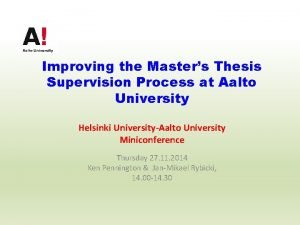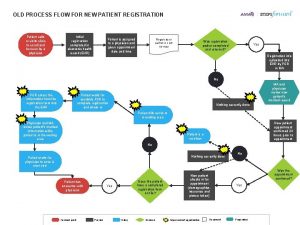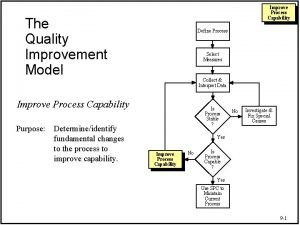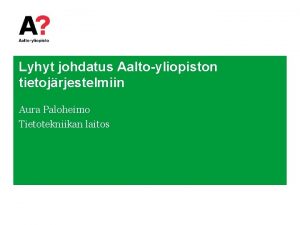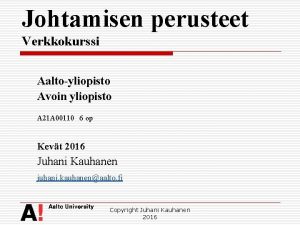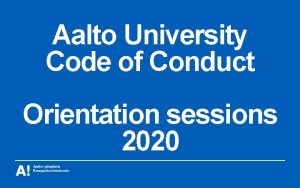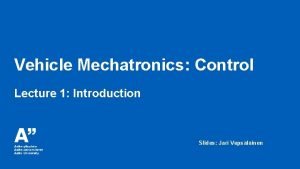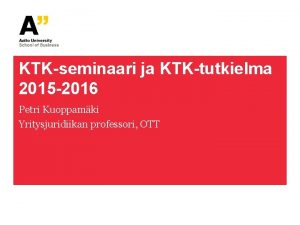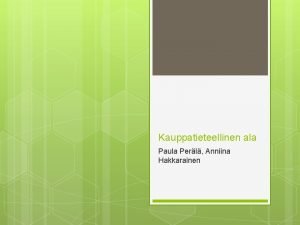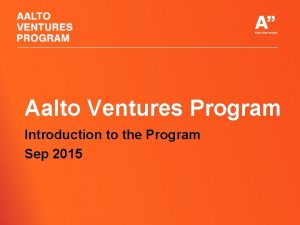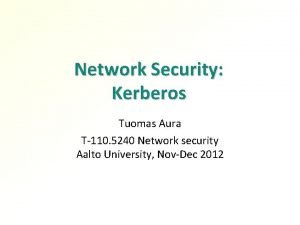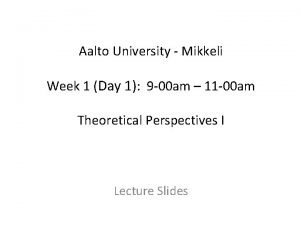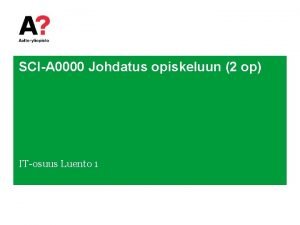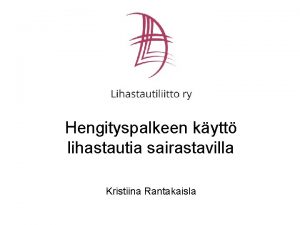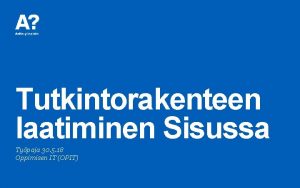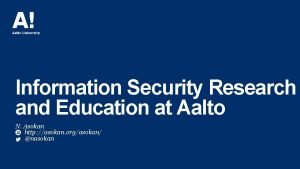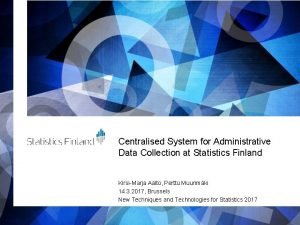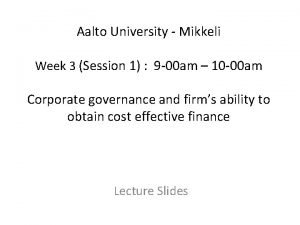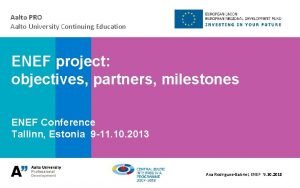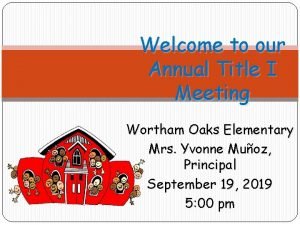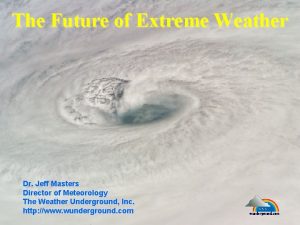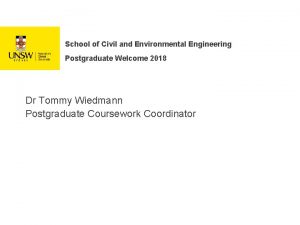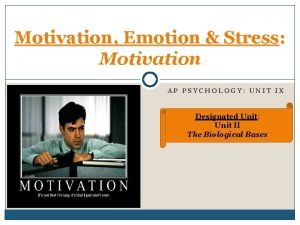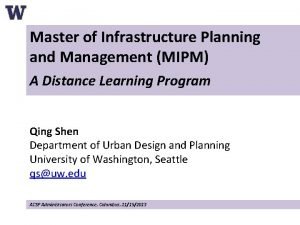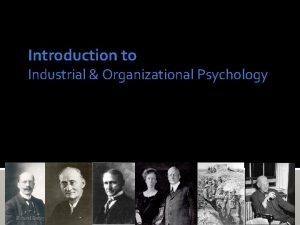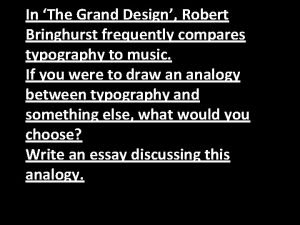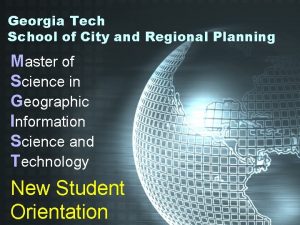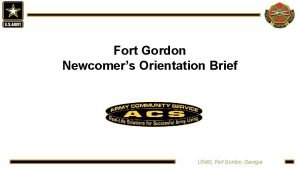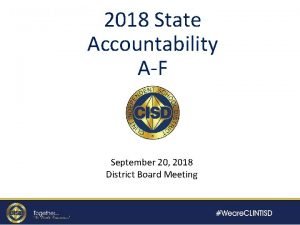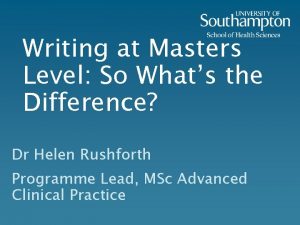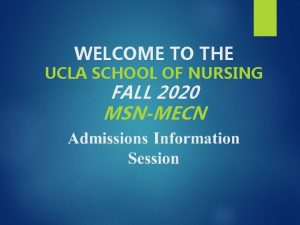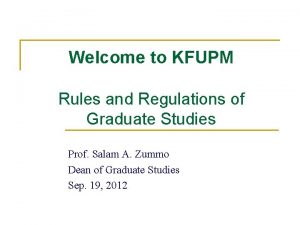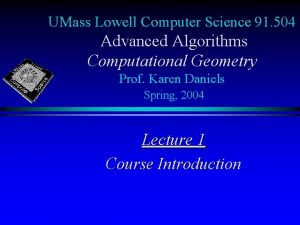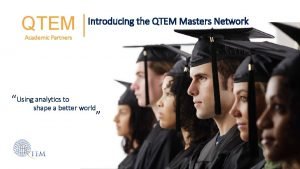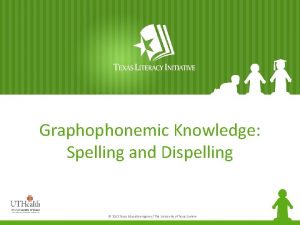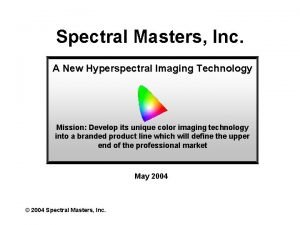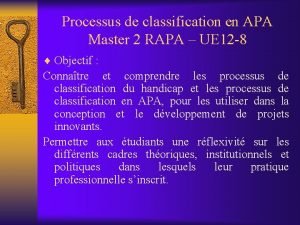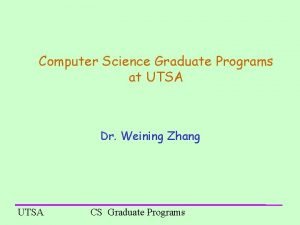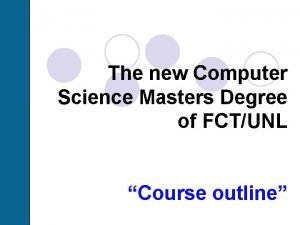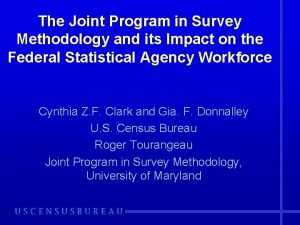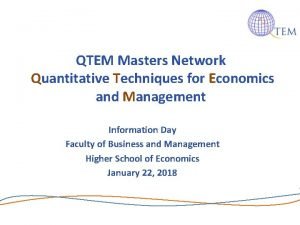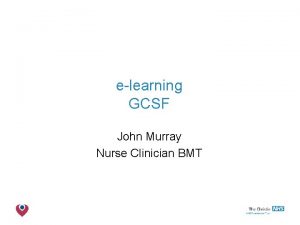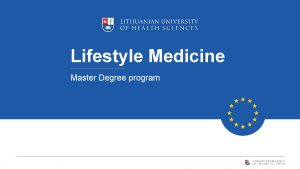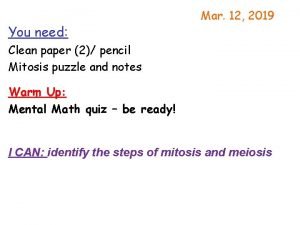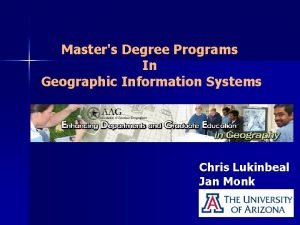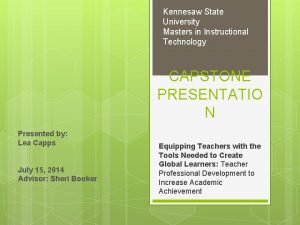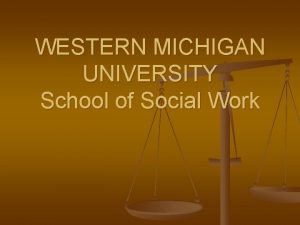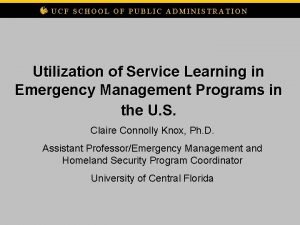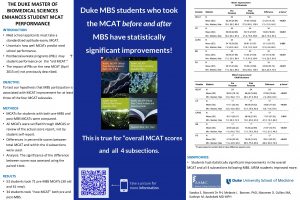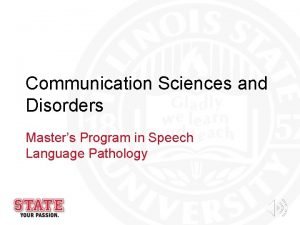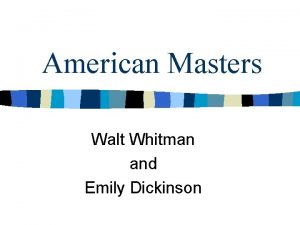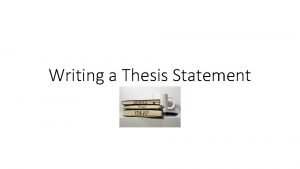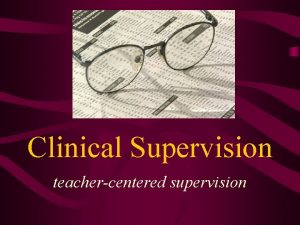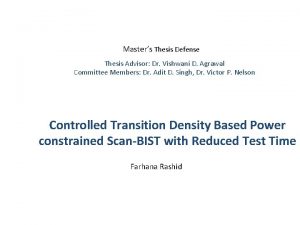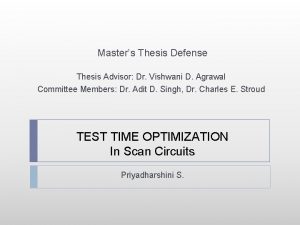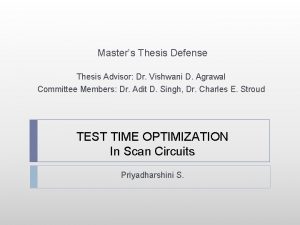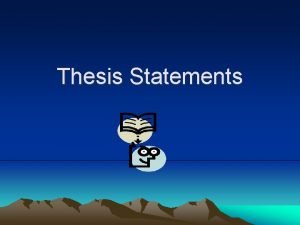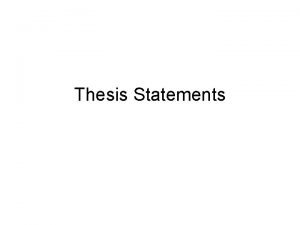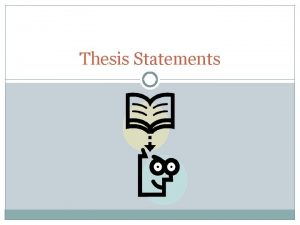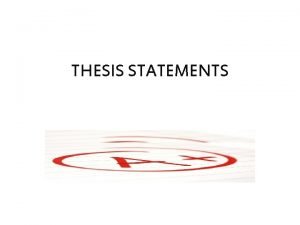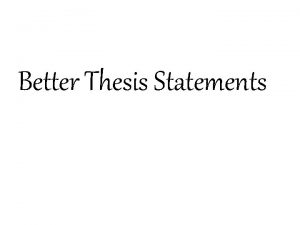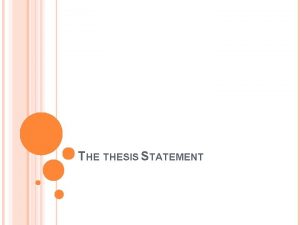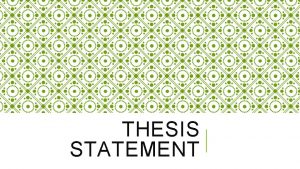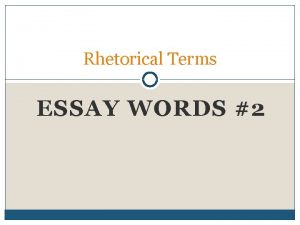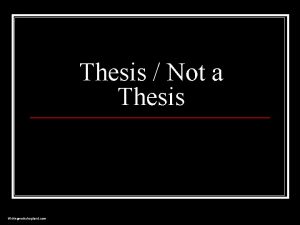Improving the Masters Thesis Supervision Process at Aalto















































































































- Slides: 111

Improving the Master’s Thesis Supervision Process at Aalto University Helsinki University-Aalto University Miniconference Thursday 27. 11. 2014 Ken Pennington & Jan-Mikael Rybicki, 14. 00 -14. 30

Background: Aalto University’s goal is to become a world-class university School of Electric Engineering (ELEC) 1. Largest school in the field of Science and Technology at Aalto 2. All ELEC master’s programs English 3. ELEC MSc theses § Highest number written in English § Writing process not to exceed six months § Detailed thesis grading rubric Aalto language Centre (LC) § § § Undergraduate introductory writing courses Master’s thesis writing course Thesis abstract correction service Writing Clinic Ph. D-level language workshops

Background: However… § Thesis quality weak § Graduation times too long § Insufficient support from LC and ELEC o Only one writing course (non-compulsory) for MSc students o No uniform thesis writing process § Help wrong time § Help not directly relevant to academic writing

Solution: Supervision of Master´s Thesis in English Workshop Participants: Both newly recruited and experienced professors in ELEC Time: Spring 2014 Five workshop sessions: 1. Process and culture of Master thesis supervision 2. The Supervisor's role 3. Creating User-Friendly Theses (Analyze sample theses using ELEC’s rubric) 4. Designing groups for thesis supervision 5. Giving and receiving feedback: assessing and evaluating theses Final Project: Designing a group process for thesis supervision

Creating User-Friendly Theses Supervision of Master´s Thesis in English 7. 4. 2014 Ken Pennington Jan-Mikael Rybicki Laura Mendoza

Creating User-Friendly Theses 1. Analysis (categories 1 -4) of sample theses 2. How would you interpret and assess the fifth category (Presentation and language)? 3. What is a user-friendly text?

STATEMENT OF MASTER’S THESIS ASSESSMENT https: //into. aalto. fi/display/enmasterelec/New+guideline+for+master%27 s+thesis+evaluatio n+effective+as+of+1+August+2012

1. Definition of research scope and goals How do you define "success" in these sub-areas? 1. 1 The research scope has been defined (Työn tehtäväalue on määritelty) 1. 2 The goals of thesis are "evident" (Työstä ilmenevät sen tavoitteet) 1. 3 The research questions and hypotheses contained in the scope of research and goals are evident from thesis. (Työstä ilmenevät tehtävän ja tavoitteiden sisältämät tutkimuskysymykset ja –olettamukset)

STATEMENT OF MASTER’S THESIS ASSESSMENT https: //into. aalto. fi/display/enmasterelec/New+guideline+for+master%27 s+thesis+evaluatio n+effective+as+of+1+August+2012

2. Command of the topic How do you define "success" in these sub-areas? 2. 1 The student demonstrates command of the topic and understanding of the scope of research (Työ osoittaa, että tutkimusaiheeseen on perehdytty ja tehtävä on oikein ymmärretty) 2. 2 The student demonstrates understanding of the relevant theoretical framework. (Työ osoittaa, että työlle merkittävä teoreettinen viitekehys on ymmärretty) 2. 3 The student demonstrates skills in making use of literature and other sources of information. (Työ osoittaa, että kirjallisuus- ja muita tietolähteitä osataan käyttää)

STATEMENT OF MASTER’S THESIS ASSESSMENT https: //into. aalto. fi/display/enmasterelec/New+guideline+for+master%27 s+thesis+evaluatio n+effective+as+of+1+August+2012

3. Methods and conclusions How do you define "success" in these sub-areas? 3. 1 The student demonstrates ability to choose justified methods for reaching the goals. (Työstä ilmenee, että opiskelija on kyennyt valitsemaan perustellut menetelmät tavoitteidensa saavuttamiseksi) 3. 2 The student demonstrates ability to apply the chosen methods. (Työ osoittaa kykyä käyttää valittuja menetelmiä) 3. 3 The thesis contains references to scientific publications. (Työssä on käytetty hyväksi kirjallisuuslähteitä) 3. 4 The thesis presents well-founded conclusions drawn from the results. (Työssä esitetään saaduista tuloksista perusteltuja johtopäätöksiä) 3. 5 The results answer the research questions presented (Tulokset vastaavat esitettyihin tutkimuskysymyksiin)

STATEMENT OF MASTER’S THESIS ASSESSMENT https: //into. aalto. fi/display/enmasterelec/New+guideline+for+master%27 s+thesis+evaluatio n+effective+as+of+1+August+2012

4. Contribution to knowledge & thesis structure How do you define "success" in these sub-areas? 4. 1 The thesis is relevant to the set goal. (Työllä on merkittävyyttä verrattuna asetettuun tavoitteeseen) 4. 2 The thesis is a well-organised logical whole. (Työ muodostaa ryhmitellyn loogisen kokonaisuuden) 4. 3 The thesis makes an original contribution to knowledge (i. e. , it is produced by the student). (Työ on alkuperäinen kontribuutio eli tekijän itsensä tuottama) Use of "We" ?

Task 1: Analysis of master’s thesis Sample Thesis #4: Nanostructured thermoelectric materials Let's divide into 4 groups! Each group will initially analyze only one sample thesis

Sample Thesis #1: Automatic Test System for Type Tests of the Uninterruptible Power Supply Final grade = "3" Criterion Grade (1 -5) Justification for the grade / comments 1. Definition of research scope and goals ? 2. Command of the topic ? 3. Methods and conclusions ? 4. Contribution to knowledge and thesis structure ? The thesis produced a prototype test system and 2 type tests that comply with IEC-62040 standards in Lab. VIEW ? Consistent presentation, the language is somewhat fluent and thesis, as a whole, is suitably executed 5. Presentation and language Determining the need for a test system and its development turned out to be too demding for a master's thesis. Student showed understanding of the topic area through a literature review. Conclusions demonstrated student's ability to objectively assess study results

Sample Thesis #2: A measurement-based analysis of machine-to-machine communications over a cellular network Final grade = "4" Criterion Grade (1 -5) Justification for the grade / comments 4 The goals of thesis are clearly defined, the scope well justified, research questions well explained, but hypothesis is hidden. 2. Command of the topic 4 3. Methods and conclusions 4 Good familiarity with research area and task, broad knowledge of both scientific literature and industry documents, but little theoretical framework Uses network measurements, to understand the deplyment status. Conclusions are general in nature 4. Contribution to knowledge and thesis structure 3 5. Presentation and language 3 1. Definition of research scope and goals Results are scarce, and some thesis goals not fulfilled Although argumentation is generally good, some parts are long discussions that include speculations and loose conclusions

Sample Thesis #3: Novel Resource-Efficient Algorithms for State Estimation in the Future Grid Criterion Grade (1 -5) Final grade = "5" Justification for the grade / comments 1. Definition of research scope and goals ? Work is precisely defined, and the goals have been reached 2. Command of the topic ? Gained a thorough understanding of challenges related to… 3. Methods and conclusions ? Novel state estimators derived 4. Contribution to knowledge and thesis structure ? 5. Presentation and language ? The results are novel and have been reported in a conference paper, as well as an IEEE paper The thesis is well organized and the written in perfect English language

Sample Thesis #4: Nanostructured thermoelectric materials Final grade = "5" Grade (1 -5) Justification for the grade / comments 1. Definition of research scope and goals ? Production of new thermoelectrical composite materials, implementation of measurement system, and compared measurements abroad. 2. Command of the topic ? Good critical review of the literature 3. Methods and conclusions ? The measurement results could easily be used to publish a research article 4. Contribution to knowledge and thesis structure ? There is still very little experimental work demonstrating that nanocontruction could improve the effectiveness of thermoelectrical conversion. 5. Presentation and language ? Criterion The work is very clear, neatly written and documented

STATEMENT OF MASTER’S THESIS ASSESSMENT https: //into. aalto. fi/display/enmasterelec/New+guideline+for+master%27 s+thesis+evaluatio n+effective+as+of+1+August+2012

5. Presentation and language 5. 1 Clarity Cohesion (topical flow, logical connectors, metalanguage) 5. 2 Structure Organization (Abstract, Introduction, Conclusion, and Paragraphing) Formatting (numbering, bulleted lists, referencing) 5. 3 Tidiness 5. 4 Scholarly style Word choice and Sentence style 5. 5 Sentence structure Complex sentences 5. 6 Grammar (e. g. , articles [the, a, Ø], tense) 5. 7 Spelling (capitalization, appostrophe [ ' ], hyphenation [ ]) Punctuation (comma [, ], colon [: ], semicolon [; ], hyphen [ ]) Other criterion

Types of engineering theses? Phillip's two-category definition (1999): 1. The Engineering Thesis (" oriented towards engineering practice") 2. The Engineering Science Thesis ("advances scientific knowledge in support of future solutions to engineering problems") Phillips, Greg. 1999. What is an engineering thesis, anyway? Retrieved March 13, 2013. http: //last 3. in/ggg/thesis. html

Types of engineering theses? Phillip's two-category definition (1999): 1. The Engineering Thesis should answer four questions: 1. What engineering problem requires a solution? 2. What's wrong with previous solutions that have attempted to solve this problem? 3. What is your solution? 4. How does your solution compare with earlier solutions? What are the weaknesses and strengths of your solution? Phillips, Greg. 1999. What is an engineering thesis, anyway? Retrieved March 13, 2013. http: //last 3. in/ggg/thesis. html

Types of engineering theses? Phillip's two-category definition (1999): 2. The Engineering Science Thesis should answer four questions: 1. What question about the world needs to be answered? 2. What's wrong with previous answers to this question? 3. What is your answer to this question? 4. How does your answer compare to earlier answers? Phillips, Greg. 1999. What is an engineering thesis, anyway? Retrieved March 13, 2013. http: //last 3. in/ggg/thesis. html

Types of engineering theses? Phillip's two-category definition (1999): 2. The Engineering Science Thesis 2. 1 Exploratory Thesis “What are the properties of system S? ” 2. 2 Experimental thesis “Is prediction P made by theory T accurate? ” 2. 3 Theoretical thesis “what theory adequately explains observations O? ” Phillips, Greg. 1999. What is an engineering thesis, anyway? Retrieved March 13, 2013. http: //last 3. in/ggg/thesis. html

Types of engineering theses? MIT's four-category definition: 1. Design of a system followed by construction, testing, and evaluation; 2. Formulation of an analytical or computational model of a system or process, simulation of the model, and comparison with actual data; 3. Development of a computer program that might: a. simulate a real system (e. g. Artificial Intelligence); b. aid in a diagnostic procedure; c. provide sophisticated, real-time analysis of measured data; d. develop and analyze a theory or theorem which is an abstraction or idealization of an actual process or system; e. apply standard methods to aid in understanding a process or system. 4. Experimental study of physical phenomena. M. Eng. Thesis Guide: parts 1 -2 -3. What is the M. Eng. Thesis? Electrical Engineering & Computer Science, Massachusetts Institute of technology. Retrieved March 13, 2013. http: //www. eecs. mit. edu/academics-admissions/undergraduate-programs/6 -p-mengprogram/thesis-guide/1 -2 -3

Types of engineering theses? Ken's (outsider’s) view: Weak claim 1. State-of-the-Art (What are available solutions? ) 2. Feasibility Study (Can this technology be successfully applied? ) 3. Recommendation (Which technology offers the best solution? ) 4. Design Problem (Does this design meet the requirements for an adequate solution) Strong claim 5. Trouble Shooting (Why don't current solutions work? )

How to structure your thesis? Experimental Engineering 1 Engineering 2 1. 2. 3. 4. 5. 1. 2. 3. 4. Introduction (Theory/Literature review) Materials and Methods Results Discussion Introduction Literature review Own contribution Conclusions Problem Methodology Solution Verification 1 Timo Laakso's structural model 2 Prof. Raimo Kantola's four-part model mentioned in Laakso's guidebook referenced below. Laakso, Timo. 1999. How to write the diploma thesis. Helsinki University of Technology. Retrieved March 13, 2013. https: //into. aalto. fi/download/attachments/1021746/how_to_write_diploma_thesis. pdf

Thesis Structure (Computer Science) Chapter 1. Introduction Chapter 6. Conclusions and Future Work Chapter 2. Literature Review Chapter 5. Evaluation Chapter 3. Design Chapter 4. Development Gordon, Damian. Literature Survey, Comprehension & Review, Lecture slides, School of Computing, Dublin Institute of Technology, Dublin, Ireland. Retrieved March 13, 2013 www. comp. dit. ie/dgordon/courses/researchmethods/Lectures/RM 0003. ppt

Thesis Structure (Computer Science) Chapter 1. Introduction Chapter 6. Conclusions and Future Work Chapter 2. Literature Review Chapter 5. Evaluation Chapter 3. Design Chapter 4. Development Gordon, Damian. Literature Survey, Comprehension & Review, Lecture slides, School of Computing, Dublin Institute of Technology, Dublin, Ireland. Retrieved March 13, 2013 www. comp. dit. ie/dgordon/courses/researchmethods/Lectures/RM 0003. ppt

How to structure your thesis? Chinneck (1999) emphasizes: "Don't make the readers work too hard! This is fundamentally important. You know what few questions the examiners need answers for. Choose section titles and wordings to clearly give them this information. The harder they have to work to ferret out your problem, your defence of the problem, your answer to the problem, your conclusions and contributions, the worse mood they will be in, and the more likely that your thesis will need major revisions". Chinneck, John W. How to Organize your Thesis. Dept. of Systems and Computer Engineering, Carleton University, Ottawa, Canada. 1999. Retrieved March 13, 2013. http: //www. sce. carleton. ca/faculty/chinneck/thesis. html

How to keep you supervisor happy? Make your text reader-friendly! Use metalanguage (i. e. , language that talks about your text) to make explicit your structure and purpose. 1. Table of Contents 2. Introduction (Chapter 1) 2. 1 Purpose statement 2. 2 Overview of thesis structure 3. 4. 5. 6. Headings and subheadings Chapter and section previews Topic sentences Linking words

The traditional IMRD Pattern Introduction (I) General Methods & materials (M) Specific Results (R) Discussion (D) Specific General Fig. 3. Overall shape of a research paper (RP) 33

Chapter 1: Introduction Does the "topic" follow a general-specific ordering? Thesis 1 "3" Thesis 2 ” 4" Thesis 3 ” 5" Thesis 4 ” 5"

Thesis #1 UPS Power failure Development process Eaton power Oy Prod. Dev. Dept. PROlaunch Tool

Thesis #1 UPS Power failure Development process Eaton power Oy Prod. Dev. Dept. PROlaunch Tool Electrical tests Verification Type tests Repeatable actions ATS

Chapter 1: Introduction Does the "topic" follow a general-specific ordering? Thesis 1 Good General-Specific ordering "3" Thesis 2 ” 4" Thesis 3 ” 5" Thesis 4 ” 5" Satisfactory General-Specific ordering Excellent General-Specific ordering Poor ordering, new topics pop up

5. Presentation and language 5. 1 Clarity Organization (Abstract, Introduction, Conclusion, and Paragraphing) 5. 2 Structure 5. 3 Tidiness 5. 4 Scholarly style 5. 5 Sentence structure 5. 6 Grammar 5. 7 Spelling Other criterion

Academic writing also employs many other organizational patterns. Problem-Solution Pattern: 1. Situation: Description of current situation 2. Problem: Identification of a problem/ need arising from the current situation 3. Solution: Description of a solution 4. Evaluation: Is the solution a good one? (Hoey, 1983) 39

The CARS Model for Journal Paper introductions MOVE 1: Establishing a Territory STEP A: Claiming centrality STEP B: Making topic generalizations STEP C: Reviewing items of previous research MOVE 2: Establishing a Niche STEP A: Counter-claiming SITUATION PROBLEM STEP B: Indicating a Gap MOVE 3: Occupying the Niche STEP A: Outlining purposes STEP B: Announcing main findings SOLUTION STEP C: Evaluating the value of the research STEP D: Indicating structure of the article EVALUATION

What about master’s thesis introductions?

What about master’s thesis introductions?

How successful are the sample theses in following the Problem-Solution Pattern?

Chapter 1: Introduction Where is the problem that motivates the aim? Thesis 1 "3" Thesis 2 ” 4" Thesis 3 ” 5" Thesis 4 ” 5"

Thesis #1 However, peforming the test involves many repeatable tasks

Chapter 1: Introduction Where is the problem that motivates the aim? Thesis 1 "3" Thesis 2 ” 4" Thesis 3 ” 5" Thesis 4 ” 5" Weak problem: not signaled by “however”, nor does he state “why” the earlier system was discontinued. BETTER: In order to categorize and group M 2 M, this thesis analyzes and identifies [what? ]

Thesis #2 AIMS? ? Motivating problem? ? AIMS again

Chapter 1: Introduction Where is the problem that motivates the aim? Thesis 1 "3" Thesis 2 ” 4" Thesis 3 ” 5" Thesis 4 ” 5" Weak problem: not signaled by “however”, nor does he state “why” the earlier system was discontinued. BETTER: In order to categorize and group M 2 M, this thesis analyzes and identifies [what? ] Larger, more complicated systems and the enormous amount of measurement data generated by new measurement technologies call for a rethinking of the traditional estimation paradigm

Thesis #3

Chapter 1: Introduction Where is the problem that motivates the aim? Thesis 1 "3" Weak problem: not signaled by “however”, nor does he state “why” the earlier system was discontinued. Thesis 2 BETTER: In order to categorize and group M 2 M, this thesis analyzes and identifies [what? ] Thesis 3 Larger, more complicated systems and the enormous amount of measurement data generated by new measurement technologies call for a rethinking of the traditional estimation paradigm ” 5" Thesis 4 ” 5" The weaknesses of “ZT” and the need for an alternative to ZT

Sample Thesis #4: Nanostructured thermoelectric materials What is the motivation (i. e. , "problem") for this thesis? (pp 3 -4)

How to keep you supervisor happy? Make your text reader-friendly! Use metalanguage (i. e. , language that talks about your text) to make explicit your structure and purpose. 1. Table of Contents 2. Introduction (Chapter 1) 2. 1 Purpose statement 2. 2 Overview of thesis structure 3. 4. 5. 6. Headings and subheadings Chapter and section previews Topic sentences Linking words

Chapter 1: Introduction What is the purpose of thesis? Thesis 1 "3" Thesis 2 ” 4" Thesis 3 ” 5" Thesis 4 The aim of this thesis is to clarify the current need for the automatic test system, and clarify requirements needed to realize it. Very confusing, since ordering is (1) purpose followed by (2) problems justifying that purpose. Confuses “scope” with “aims”

Thesis #2 ” 4" AIMS? ? Motivating problem? ? AIMS again

Chapter 1: Introduction What is the purpose of thesis? Thesis 1 "3" Thesis 2 ” 4" Thesis 3 ” 5" Thesis 4 The aim of this thesis is to clarify the current need for the automatic test system, and clarify requirements needed to realize it. Very confusing, since ordering is (1) purpose followed by (2) problems justifying that purpose. Confuses “scope” with “aims” Excellent problem-solution argumentation. The introduction is divided into 4 sections: motivation, scope, contributions and organization.

Chapter 1: Introduction The aim of this thesis is to clarify the current need for the automatic test system, and clarify requirements needed to realize it. Very confusing, since ordering is (1) purpose followed by (2) problems justifying that purpose. Confuses “scope” with “aims”

Sample Thesis #4: Nanostructured thermoelectric materials What is the purpose (i. e. , "aim") for this thesis? Not in the abstract Not in the Introduction Grade = ” 5" Not in the Conclusions

Chapter 1: Introduction What is the purpose of thesis? Thesis 1 "3" Thesis 2 ” 4" Thesis 3 ” 5" Thesis 4 The aim of this thesis is to clarify the current need for the automatic test system, and clarify requirements needed to realize it. Very confusing, since ordering is (1) purpose followed by (2) problems justifying that purpose. Confuses “scope” with “aims” Excellent problem-solution argumentation. The introduction is divided into 4 sections: motivation, scope, contributions and organization. No purpose statement!

How to keep you supervisor happy? Make your text reader-friendly! Use metalanguage (i. e. , language that talks about your text) to make explicit your structure and purpose. 1. Table of Contents 2. Introduction (Chapter 1) 2. 1 Purpose statement 2. 2 Overview of thesis structure 3. 4. 5. 6. Headings and subheadings Chapter and section previews Topic sentences Linking words

Chapter 1: Introduction Is the "overview of structure" successful? Thesis 1 "3" Thesis 2 ” 4" Thesis 3 ” 5" Thesis 4 ” 5"

Chapter 1: Introduction Is the "overview of structure" successful? Thesis 1 "3" Thesis 2 ” 4" Thesis 3 ” 5" Thesis 4 ” 5" Too much detail; most info would have been better moved to section or chapter previews

Thesis #1

Chapter 1: Introduction Is the "overview of structure" successful? Thesis 1 "3" Thesis 2 ” 4" Thesis 3 ” 5" Thesis 4 ” 5" Too much detail; most info would have been better moved to section or chapter previews Lacks introductory topic sentence. Abuses “focuses on”. The verbs are empty in meaning, fail to describe the function and relationship between the chapters.

Thesis #2

Chapter 1: Introduction Is the "overview of structure" successful? Thesis 1 "3" Thesis 2 ” 4" Thesis 3 ” 5" Thesis 4 ” 5" Too much detail; most info would have been better moved to section or chapter previews Lacks introductory topic sentence. Abuses “focuses on”. The verbs are empty in meaning, fail to describe the function and relationship between the chapters. Good. Uses introductory topic sentence: “The remainder of this work is organized as follows. ” However, meta-language is affected by obtrusive use of authorfocused “we”

Thesis #3

Chapter 1: Introduction Is the "overview of structure" successful? Thesis 1 "3" Thesis 2 ” 4" Thesis 3 ” 5" Thesis 4 ” 5" Too much detail; most info would have been better moved to section or chapter previews Lacks introductory topic sentence. Abuses “focuses on”. The verbs are empty in meaning, fail to describe the function and relationship between the chapters. Good. Uses introductory topic sentence: “The remainder of this work is organized as follows. ” However, meta-language is affected by obtrusive use of authorfocused “we” No overview in introduction! (the abstract describes structure)

How to keep you supervisor happy? Make your text reader-friendly! Use metalanguage (i. e. , language that talks about your text) to make explicit your structure and purpose. 1. Table of Contents 2. Introduction (Chapter 1) 2. 1 Purpose statement 2. 2 Overview of thesis structure 3. 4. 5. 6. Headings and subheadings Chapter and section previews Topic sentences Linking words

Metalanguage: Chapter and section previews Previews contents of chapter

Metalanguage: Chapter and section previews Restate-forecast

Metalanguage: Chapter and section previews Previews contents of section

Chapter 1: Introduction Any chapter or section previews (whole thesis)? Thesis 1 "3" Thesis 2 ” 4" Thesis 3 ” 5" Thesis 4 ” 5" 1 chapter preview, but 10 section previews (3 at end of previous section) Yes, 3 chapter previews and 1 section preview. However, empty in meaning, fail to describe the function and relationship between the chapters. Yes, 3 chapter previews and 5 section previews, as well as “Discussion sections” at the end of each chapter. However, meta-language is affected by obtrusive use of author-focused “we” (e. g. , Section 4. 3) No chapter preview, only 1 section preview.

How to keep you supervisor happy? Make your text reader-friendly! Use metalanguage (i. e. , language that talks about your text) to make explicit your structure and purpose. 1. Table of Contents 2. Introduction (Chapter 1) 2. 1 Purpose statement 2. 2 Overview of thesis structure 3. 4. 5. 6. Headings and subheadings Chapter and section previews Topic sentences Linking words

Chapter 1: Introduction Any topic sentences (whole thesis)? Thesis 1 "3" Thesis 2 ” 4" Thesis 3 ” 5" Yes, some, though not many, claims followed by supporting info Almost none, though several used to introduce vertical bulleted lists. Most sentences introducing paragraphs are definitions. . Yes, Many! Thesis 4 No topic sentences that summarize or interpret the main message of the paragraph.

h Metalanguage: Topic Sentences (enumeration) Thesis #3

h Metalanguage: Topic Sentences (claim) Thesis #3

5. Presentation and language 5. 1 Clarity Cohesion (topical flow, logical connectors, metalanguage) 5. 2 Structure Organization (Abstract, Introduction, Conclusion, and Paragraphing) 5. 3 Tidiness Word choice and Sentence style 5. 4 Scholarly style 5. 5 Sentence structure 5. 6 Grammar 5. 7 Spelling Other criterion

Thesis #1 2 Background 2. 1 Automatic Test System An automatic test system generally means a system which performs any kind of An automatic test system generally refers to a system which performs any a system which automatically a system which performs tests , type a system which performs tests , such An automatic test system generally refers to to a system which automatically An automatic test system generally refers of tests such as electrical measurements, mechanical actions or software related tests, performs tests such as electrical measurements, mechanical actions or software related tests , performs tests, , such as electrical measurements, mechanical actions or software performs tests automatically for a device under test (DUT). In this chapter, basic elements of the ATS tests, automatically for a device under test (DUT). In this chapter, basic elements of the related tests for a device under test (DUT). In this chapter, basic elements of the automatically for a device under test (DUT). In this chapter, basic elements of the ATS related tests , , for a device under test (DUT). In this chapter, basic elements of the for a device under test (DUT). This chapter discusses basic ATS is discussed according to various sources. the ATS is discussed according to various sources. ATS are discussed according to various sources. elements of the ATS using / based on various sources. ATS are discussed according to various sources. elements of the ATS according to various sources.

Thesis #2 Grade = ” 4" It’s hard for some use cases to examine if the application is really a machine based or a human based. The outlining is getting blur, especially when the application is judged purely from the network usage point of view (bottom-up). This is due to a fact that many of the devices are built so that they can be used for serving the needs of both M 2 M and H 2 H. This is especially the case for consumer targeted devices. For example, a normal computer can be running a M 2 M type of an application, but if it is using a typical integrated or USB (Universal Serial Bus) connected cellular modem, normal subscription and public APN, it can be reliably recognized as M 2 M only after a detailed packet capture and analysis. It is difficult in some use cases to determine whether an application is actually machine-based or a humanbased. The distinction has become blurred, especially when assessing the application purely in terms of network usage (bottom-up), since many of the devices are built for serving the needs of both M 2 M and H 2 H. This is especially the case for consumer targeted devices. For example, although a normal computer can be operating a M 2 M application, if it is using a typical integrated or USB (Universal Serial Bus) connected cellular modem, normal subscription and public APN, it can be reliably recognized as M 2 M only after a detailed packet capture and analysis.

5. Presentation and language 5. 1 Clarity Cohesion (topical flow, logical connectors, metalanguage) 5. 2 Structure Organization (Abstract, Introduction, Conclusion, and Paragraphing) Formatting (numbering, bulleted lists, referencing) 5. 3 Tidiness 5. 4 Scholarly style Word choice and Sentence style 5. 5 Sentence structure Complex sentences 5. 6 Grammar (e. g. , articles [the, a, Ø], tense) 5. 7 Spelling (capitalization, appostrophe [ ' ], hyphenation [ ]) Punctuation (comma [, ], colon [: ], semicolon [; ], hyphen [ ]) Other criterion

A more exemplary thesis introduction B. Kyazze, “Centralized Ethernet Switching, ” M. Sc. thesis, School of Electricakl Engineering, Dept. of Communications and Networking, Aalto University, Helsinki, Finland, 2013.

What about master’s thesis introductions?

Exercise 4 -3: Master’s thesis introductions 1. Identify and label the Adapted CARS moves and steps in the following Master’s thesis introduction. 2. Draw lines between each move and step (the first part has been done for you). 3. Circle language features used to signal each move? 4. Can you identify any stylistic problems that need improvement?

Exercise 4 -3: Master’s thesis introductions 1 1 Daily communication using mobile phones and the Move 1 -A: Claiming centrality Internet has increasingly become dependent on fast 2 Today, and effective networks for transferring data. fast and effective networks for transferring data. 2 Today, high-speed connections are required for many Internet applications, including Vo. IP for web telephoning and Bit. Torrent for downloads of movies. 3 3 Current networks technologies have struggled to cope with these increasing demands, leading to the development of various technologies, such as Frame Relay, Token Ring, and Fiber Distributed Data Interface (FDDI). 44 Token Ring was among the first protocols to be implemented for data transmission. 5 5 However, it proved to be inefficient because of the various collisions over the domains. 66 In response to these weaknesses, the Frame Relay protocol and Ethernet were developed. 88 Although the Frame Relay protocol has been shown to be easily deployable in wide-area networks, it remains too slow for many current applications, due to bandwidth problems. 99 As As

Exercise 4 -3: Master’s thesis introductions 11 Daily communication using mobile phones and the Move 1 -A: Claiming centrality Move 2 -B: Identifying a problem Move 1 -C: Previous Research Internet has increasingly become dependent on fast and effective networks for transferring data. 22 Today, high-speed connections are required for many Internet applications, including Vo. IP for web telephoning and Bit. Torrent for downloads of movies. 33 Current networks technologies have struggled to cope with these increasing demands, leading to the development of various technologies, such as Frame Relay, Token Ring, and Fiber Distributed Data as Frame Relay, Token Ring, and Fiber Distributed 4 Token Ring was among the first 4 Token Ring was among the Interface (FDDI). Data Interface (FDDI). protocols to be implemented for data transmission. first protocols to be implemented for data 5 transmission. 5 However, it proved to be inefficient because of the 6 In response to various collisions over the domains. because of the various collisions over the domains. 6 In response to these weaknesses, the Frame Relay protocol and 8 Although the Frame Relay 8 Although the Ethernet were developed. protocol and Ethernet were developed. protocol has been shown to be easily deployable in Frame Relay protocol has been shown to be easily wide-area networks, it remains too slow for many deployable in wide-area networks, it remains too slow current applications, due to bandwidth problems. for many current applications, due to bandwidth 9 As

Exercise 4 -3: Master’s thesis introductions 1 1 Daily communication using mobile phones and the Move 1 -A: Claiming centrality Move 2 -B: Identifying a problem Move 1 -C: Previous Research Move 1 -B: Topic Generalization Internet has increasingly become dependent on fast and effective networks for transferring data. 2 2 Today, high-speed connections are required for many Internet applications, including Vo. IP for web telephoning and Bit. Torrent for downloads of movies. 3 3 Current networks technologies have struggled to to cope with these increasing demands, leading to to the development of various technologies, such as Frame Relay, Token Ring, and Fiber Distributed 4 Data Interface (FDDI). 4 Token Ring was among the Token Ring was among first protocols to be implemented for data the first protocols to be implemented for data 5 transmission. 5 However, it proved to be inefficient because of the various collisions over the domains. 6 6 In response to these weaknesses, the Frame Relay 8 protocol and Ethernet were developed. 8 Although the Frame Relay protocol has been shown to be easily deployable in wide-area networks, it remains too slow for many current applications, due to bandwidth

Exercise 4 -3: Master’s thesis introductions 1 Daily communication using mobile phones and the Move 1 -A: Claiming centrality Move 2 -B: Identifying a problem Move 1 -C: Previous Move 1 -B: Research Topic Move 2 -B: Generalization Identifying a problem Internet has increasingly become dependent on fast and effective networks for transferring data. 2 Today, high-speed connections are required for many Internet applications, including Vo. IP for web telephoning and Bit. Torrent for downloads of movies. 3 Current networks technologies have struggled to cope with these increasing demands, leading to the development of various technologies, such as as Frame Relay, Token Ring, and Fiber Distributed Data 4 Token Ring was among the Data Interface (FDDI). 4 Token Ring was among the first protocols to be implemented for data transmission. 5 However, it proved to be inefficient because of 5 However, it proved to be inefficient transmission. because of the various collisions over the domains. 6 In response 6 In response to these weaknesses, the Frame Relay protocol and 8 Although the protocol and Ethernet were developed. 8 Although the Frame Relay protocol has been shown to be easily deployable in wide-area networks, it remains too slow for many current applications, due to bandwidth problems. 9 As a

Exercise 4 -3: Master’s thesis introductions 1 Daily communication using mobile phones and the Move 1 -A: Claiming centrality Move 2 -B: Identifying a problem Move 1 -C: Previous Move 1 -B: Research Topic Move 2 -B: Generalization Identifying a problem Move 1 -B: Topic Generalization Internet has increasingly become dependent on fast and effective networks for transferring data. 2 Today, high-speed connections are required for many Internet applications, including Vo. IP for web telephoning and Bit. Torrent for downloads of movies. 3 Current networks technologies have struggled to cope with these increasing demands, leading to the development of various technologies, such as Frame Relay, Token Ring, and Fiber Distributed Data Interface (FDDI). 4 Token Ring was among the first protocols to be implemented for data transmission. 5 However, it proved to be inefficient because of the various collisions over the domains. 6 In response to these weaknesses, the Frame Relay protocol and 8 Although the Frame Relay Ethernet were developed. protocol has been shown to be easily deployable in Relay protocol has been shown to be easily deployable wide-area networks, it remains too slow for many in wide-area networks, it remains too slow for many current applications, due to bandwidth problems. 9 As a

Exercise 4 -3: Master’s thesis introductions Relay protocol and Ethernet were developed. 8 Although the Although Frame Relay protocol has been shown to be easily the Frame Relay protocol has been shown to be easily deployable in wide-area networks, it remains too slow for many current applications, due to bandwidth 9 As a result, both FDDI and the Ethernet bandwidth problems. have continued to be widely deployed because of their Ethernet have continued to be widely deployed 10 However, since FDDI high communication speeds. because of their high communication speeds. 10 However, since FDDI relies on optical fiber cables, it remains prohibitively 11 Thus, Ethernet has expensive and difficult to install. remains prohibitively expensive and difficult to install. 11 Thus, Ethernet has become the leading choice for transferring data over Local Area Networks (LANs), due to its many transferring data over Local Area Networks (LANs), due advantages, including low cost, easy implementation, to its many advantages, including low cost, easy flexibility in installations, high speed, and wide implementation, flexibility in installations, high speed, compatibility with other standards. and wide compatibility with other standards. 6 In response to these weaknesses, the Frame Move 1 -B: Topic Generalization Move 1 -C: Previous Research Move 2 -B: Identifying a problem

Exercise 4 -3: Master’s thesis introductions Move 1 -B: Topic Generalization Move 1 -C: Previous Research Move 2 -B: Identifying a Move 1 -B: problem Topic Generalization 6 In response to these weaknesses, the Frame Relay 6 In response to these weaknesses, the Frame Relay protocol and Ethernet were developed. 88 Although protocol and Ethernet were developed. Although the Frame Relay protocol has been shown to be the Frame easily deployable in wide-area networks, it remains easily too slow for many current applications, due to too bandwidth problems. 99 As a result, both FDDI and the bandwidth problems. Ethernet have continued to be widely deployed because of their high communication speeds. 10 However, since FDDI relies on optical fiber cables, it 10 However, since FDDI relies on optical fiber cables, it remains prohibitively expensive and difficult to install. 11 Thus, Ethernet has become the leading choice for 11 Thus, Ethernet has become the leading choice for transferring data over Local Area Networks (LANs), due to its many advantages, including low cost, easy implementation, flexibility in installations, high speed, and wide compatibility with other standards.

Exercise 4 -3: Master’s thesis introductions 66 In response to these weaknesses, the Frame Relay Move 1 -B: Topic Generalization Move 1 -C: Previous Research Move 2 -B: Counter. Move 1 -B: claiming Topic Generalization Move 2 -B: Identifying a problem protocol and Ethernet were developed. 88 Although the Frame Relay protocol has been shown to be easily deployable in wide-area networks, it remains too slow for many current applications, due to bandwidth problems. 99 As a result, both FDDI and the Ethernet have continued to be widely deployed because of their high communication speeds. 10 10 However, since FDDI relies on optical fiber cables, it remains prohibitively expensive and difficult to install. 11 Thus, Ethernet has become the 11 11 Thus, Ethernet has become the leading choice for difficult to install. Thus, Ethernet has become the leading choice for transferring data over Local Area Networks (LANs), due to its many advantages, including low cost, easy Networks (LANs), due to its many advantages, including low cost, easy implementation, flexibility in installations, high speed, and wide compatibility with other standards. installations, high speed, and wide compatibility with other standards.

Exercise 4 -3: Master’s thesis introductions 66 In response to these weaknesses, the Frame Relay Move 1 -B: Topic Generalization Move 1 -C: Previous Research Move 2 -B: Identifying a Move 1 -B: problem Topic claiming Move 2 -B: Generalization Identifying a problem Move 1 -B: Topic Generalization protocol and Ethernet were developed. 88 Although protocol and Ethernet were developed. the Frame Relay protocol has been shown to be the Frame easily deployable in wide-area networks, it remains easily too slow for many current applications, due to too bandwidth problems. 99 As a result, both FDDI and the bandwidth problems. Ethernet have continued to be widely deployed because of their high communication speeds. 10 However, since FDDI relies on optical fiber 10 However, since FDDI relies on optical fiber cables, it remains prohibitively expensive and cables, it remains prohibitively 11 Thus, Ethernet has become difficult to install. 11 difficult to install. Thus, Ethernet has become the leading choice for transferring data over Local Area Networks (LANs), due to its many advantages, including low cost, easy implementation, flexibility in in installations, high speed, and wide compatibility with other standards.

Exercise 4 -3: Master’s thesis introductions 12 Despite these advantages, the Ethernet protocol Move 2 -B: Identifying a problem protocol has suffered from some notable weaknesses, including scalability, delays, packet losses, band width choke points, security and unidirectional link 13 Recently, and unidirectional link failures. 13 Recently, considerable attention has focused on solving most of these problems [1 -5]. 14 These solutions have included TRILL, Shortest 14 These solutions have of these problems [1 -5]. included TRILL, Shortest Path Bridging (SPB), CISCO and Juniper solutions. 15 More recently, other approaches (e. g. , ETHANE, 15 More recently, other CISCO and Juniper solutions. approaches (e. g. , ETHANE, EU ETNA, Open flow) have been proposed to improve the efficiency of Ethernet. 16 However, despite all these solutions, Ethernet. despite all these solutions, they have focused mostly on data transmissions within LAN networks (i. e. , use either a centralized or distributed data movement approach), and little or no attention has been directed towards their scalability. 17 To address these Ethernet problems, this thesis will examine the feasibility of scaling the centralised Ethernet routing approach.

Exercise 4 -3: Master’s thesis introductions Move 2 -B: Identifying a problem Move 1 -C: Previous Research 12 Despite these 12 advantages, the Ethernet protocol has suffered from some notable weaknesses, including scalability, delays, packet losses, band width choke points, security 13 Recently, and unidirectional link failures. 13 Recently, considerable attention has focused on solving most considerable attention has focused on solving 14 These solutions have of these problems [1 -5]. most of these problems [1 -5]. 14 These included TRILL, Shortest Path Bridging (SPB), solutions have included TRILL, Shortest Path CISCO and Juniper solutions. 15 More recently, other Bridging (SPB), CISCO and Juniper solutions. 15 approaches (e. g. , ETHANE, EU ETNA, Open flow) More recently, other approaches (e. g. , have been proposed to improve the efficiency of ETHANE, EU ETNA, Open flow) have been Ethernet. 16 However, despite all these solutions, proposed to improve the efficiency of Ethernet. 16 they have focused mostly on data transmissions However, despite all these solutions, they have within LAN networks (i. e. , use either a centralized or focused mostly on data transmissions within LAN distributed data movement approach), and little or no networks (i. e. , use either a centralized or distributed attention has been directed towards their scalability. data movement approach), and little or no attention 17 To address these Ethernet problems, this thesis has been directed towards their scalability. will examine the feasibility of scaling the centralised Ethernet routing approach.

Exercise 4 -3: Master’s thesis introductions Move 2 -B: Identifying a problem Move 1 -C: Previous Research Move 2 -A: Indicating a Gap 12 Despite these advantages, the Ethernet protocol has suffered from some notable weaknesses, including scalability, delays, packet losses, band width choke points, security and unidirectional link failures. 13 Recently, considerable attention has focused on solving most of these problems [1 -5]. 14 These solutions have included TRILL, Shortest Path Bridging (SPB), CISCO and Juniper solutions. 15 More recently, other approaches (e. g. , ETHANE, EU ETNA, Open flow) have been proposed to improve the efficiency of Ethernet. 16 However, despite all these solutions, they have However, despite all these solutions, they focused mostly on data transmissions within LAN have focused mostly on data transmissions within networks (i. e. , use either a centralized or distributed LAN networks (i. e. , use either a centralized or distributed data movement approach), and little or no attention 17 To no attention has been directed towards their scalability. address these Ethernet problems, this thesis will scalability. 17 To address these Ethernet problems, examine the feasibility of scaling the centralised this thesis will examine the feasibility of scaling the

Exercise 4 -3: Master’s thesis introductions 16 16 However, Move 2 -A: Indicating a Gap Move 3 -1: Outlining Purposes despite all these solutions, they have focused mostly on data transmissions within LAN networks (i. e. , use either a centralized or distributed data movement approach), and little or no no attention has been directed towards their 17 To address these Ethernet problems, scalability. 17 To address these Ethernet this thesis will examine the feasibility of scaling the problems, this thesis will examine the 18 For this centralised Ethernet routing approach. feasibility of scaling the centralised Ethernet purpose, thesis developed a centralized routing approach. 18 For this purpose, the solution, which was then compared using three thesis developed a centralized routing solution, parameters (delays, packet loss and convergence which was then compared using three times) to the current distributed Ethernet routing parameters (delays, packet loss and convergence approach. times) to the current distributed Ethernet routing approach.

Exercise 4 -3: Master’s thesis introductions 19 19 In this study, we used the Boson network simulator In this study, we used the Boson network Move 3 -3: Methodology using topologies with 10, 19 and 38 operational nodes. simulator using topologies with 10, 19 and 38 20 These settings were used to compare both the operational nodes. 20 These settings were used to centralized and the distributed Ethernet systems, compare both the centralized and the distributed focusing on three parameters: convergence times, Ethernet systems, focusing on three parameters: 21 The results show that in terms packet loss and delay. 21 The convergence times, packet loss and delay. of these parameters, the proposed centralized routing results show that in terms of these parameters, the solution is best used in LANs with fewer nodes, proposed centralized routing solution is best used in whereas larger networks with more than 19 nodes LANs with fewer nodes, whereas larger networks with should use a distributed system. more than 19 nodes should use a distributed system. 1. 2 Problem statement. 22 This thesis looks at centralized Ethernet routing as an 22 This thesis looks at centralized Ethernet routing as an alternative to the distributed Ethernet routing with the focus on scalability, convergence times, packet loss 23 and delay. 23 In other words, the thesis will check to what extent the centralized Ethernet routing can scale 24 and become a solution to Ethernet problems. 24 In an

Exercise 4 -3: Master’s thesis introductions 19 19 In this study, we used Move 3 -3: Methodology Move 3 -4: Contribution the Boson network simulator using topologies with 10, 19 and 38 20 These settings were operational nodes. 20 These settings were used to to compare both the centralized and the distributed Ethernet systems, focusing on on three parameters: 21 The convergence times, packet loss and delay. 21 The results show that in terms of these parameters, the proposed centralized routing solution is best used in LANs with fewer nodes, whereas larger networks with more than 19 nodes should use a distributed system. 1. 2 Problem statement. 22 22 This thesis looks at centralized Ethernet routing as an alternative to the distributed Ethernet routing with the focus on scalability, convergence times, packet loss 23 In other words, thesis will check to and delay. 23 In other words, thesis will check to what extent the centralized Ethernet routing can scale

Exercise 4 -3: Master’s thesis introductions 1. 2 Problem statement. 22 This thesis looks at centralized Ethernet routing as an Move 3 -1: Outlining Purposes as an alternative to the distributed Ethernet routing with the focus on scalability, convergence times, packet loss 23 In other words, thesis packet loss and delay. 23 In other words, thesis will check to what extent the centralized Ethernet routing can scale and become a solution to Ethernet problems. 24 In an routing can scale and become a solution to Ethernet 24 In an attempt to answer the above question, a comparison problems. between the centralized and distributed Ethernet question, a comparison between the centralized and routing focusing on three parameters (delays, packet distributed Ethernet routing focusing on three loss and convergence times) was looked at. parameters (delays, packet loss and convergence This section was not times) was looked at. necessary, but was included because of department requirements. Nevertheless, this is not a problem statement. What is it?

Exercise 4 -3: Master’s thesis introductions 1. 2 Problem statement. 22 This thesis Move 3 -1: Outlining Purposes Move 3 -3: Methodology looks at centralized Ethernet routing as an alternative to the distributed Ethernet routing with the focus on scalability, convergence times, packet loss and delay. 23 In other words, thesis will check to what extent the centralized Ethernet routing can scale and become a solution to Ethernet problems. 24 In an attempt to answer the above question, a comparison between the centralized and distributed Ethernet routing focusing on three parameters (delays, packet loss and convergence times) was looked at.

Exercise 4 -3: Master’s thesis introductions 1. 3 Objectives and Scope. 25 26 First, 25 This thesis had two 26 First, to main objectives. This thesis had two main objectives. Move 3 -1: Outlining Purposes to overcome current Ethernet problems, such as packet loss, choke points and delays, this thesis develops a centralized Ethernet solution by analyzing the maximum number of nodes needed to provide the least amount of packet loss, delay and convergence 27 Another objective is to convergence times. 27 Another objective is to determine the feasibility of our solution by comparing it with the existing distributed solution. 1. 4 Structure Where is the scope? 28 28 The thesis is divided into five chapters. 29 Chapter What has been The thesis is divided into five chapters. 29 Chapter two describes the devices, various topologies and excluded from the technologies used in legacy Ethernet, as well as analysis? highlights the main weaknesses and solutions for that 30 Chapter three summarizes recent advanced period, . 30 Chapter three summarizes recent advanced

Exercise 4 -3: Master’s thesis introductions 1. 4 Structure 28 The thesis is divided into five chapters. 29 Chapter Move 3 -5: Overview of thesis structure 29 Chapter two describes the devices, various topologies and technologies used in legacy Ethernet, as well as highlights the main weaknesses and solutions for that 30 Chapter three summarizes recent advanced solutions for that period. summarizes recent advanced solutions to Ethernet, including TRILL, Shortest Path Bridging (SPB), Cisco solutions and Juniper solutions. 31 Chapter four 31 solutions and Juniper solutions. Chapter four reviews various research proposals directed towards improving Ethernet, including 32 In chapter five, a towards improving Ethernet, including Ethane, ETNA and. Open flow. 32 In chapter five, a centralized solution is presented and compared with solution is presented 33 and compared with the distributed system. Chapter six discusses the distributed system. 33 Chapter six discusses the finding and suggests future areas of research.

What did we find out? Quality control • No department- or school-wide practices (inconsistent or ad hoc) • Rubric exists, but not in wide use Conflicting interests • Students carry out thesis for an external stakeholder, a client company • Different expectations of company and university • Unsure of the role of the company advisor or the advisor’s academic qualifications Language issues • Lack expertise in language issues • Unfamiliar with process writing Time constraints • Overworked supervisors (no time to deal with language problems) • Unsure of how to deal with special requirements of international students

What did we find out? Very eager to get LC to guide student writing Implementing a process: 1. creating milestones 2. Establishing a thesis seminar 3. Integrating language teaching and feedback

LC Proposal: Master’s Thesis Seminar Time scale: Second half of first year Length: 3 Semesters (9 months) Instructors: Professor(s) + Language teachers

LC Proposal: 1 2 3 4 First year (Periods 3 -4) Theme Professor Language instructor 1. Finding a client and a Supervisor § Language issues 2. Information search and management Library staff Language issues 3. Avoiding plagiarism Analysis of past theses: - What to cite? § 4. Thesis Structure § § § 5. Annotated Bibliography Example Advisor. Supervisor contracts Case studies Thesis assessment rubric Analysis of past theses : - Overall structure - Methods - validation/ verification Analysis of past theses: - Focus on methods Differences between Research articles and the Master’s thesis § § 6. Thesis Proposal Information- vs. authorprominent citations, reporting verbs, tense § Outlining (Reverse engineering) Paraphrasing and summarizing strategies Structure and content of TP

What will you do during this course? information About Target text Analysis of example texts Discuss analysis in class Target texts: 1. Annotated bibliography 2. Thesis proposal FINAL VERSION Revise Text Feedback on Language Revise Text Write target text Feedback on content & structure 3. Presenting and interpreting results 4. Theory/Literature review 5. Introduction 6. Abstract

LC Proposal: 2 3 4 Theme (6 weeks) 1 Second year (Periods 1 -2) Professor Language instructor 7. Presenting and Analysis of past theses: interpreting § Figures and visuals results Analysis of past theses: § Structure, content and language 8. Writing task: Results chapter Small-group, peer-feedback sessions: § Structure & Cohesion Feedback on content Revision task: Results chapter On-line Teacher feedback 9. Theory/Literatu Analysis of past theses re review (6 weeks) Analysis of past theses: § Structure, content and language 10. Writing task: Lit. Review Revision task: Lit. Review Feedback on content Small-group, peer-feedback sessions: § Structure & Cohesion On-line Teacher feedback

LC Proposal: 2 3 4 Theme (6 weeks) 1 Second year (Periods 3 -4) Professor Language instructor 7. Presenting and Analysis of past theses: interpreting § Figures and visuals results Analysis of past theses: § Structure, content and language 8. Writing task: Results chapter Small-group, peer-feedback sessions: § Structure & Cohesion Feedback on content Revision task: Results chapter On-line Teacher feedback 9. Theory/Literatu Analysis of past theses re review (6 weeks) Analysis of past theses: § Structure, content and language 10. Writing task: Lit. Review Revision task: Lit. Review Feedback on content Small-group, peer-feedback sessions: § Structure & Cohesion On-line Teacher feedback

LC Proposal: 1 2 3 4 Second year (Periods 3 -4) Theme Professor Language instructor 11. Chapter 1 Introduction Analysis of past theses: § The CARS Model 12. Writing task: Introduction Feedback on content Small-group, peer-feedback sessions: § Structure & Cohesion Revision task: Introduction On-line Teacher feedback 13. Abstracts Analysis of past theses: § Structure, content and language 14. Writing task: Abstract Feedback on content Small-group, peer-feedback sessions: § Structure & Cohesion Revision task: Abstract On-line Teacher feedback

LC Proposal: 1 2 3 4 Second year (Periods 3 -4) Theme Professor Language instructor 11. Chapter 1 Introduction Analysis of past theses: § The CARS Model 12. Writing task: Introduction Feedback on content Small-group, peer-feedback sessions: § Structure & Cohesion Revision task: Introduction On-line Teacher feedback 13. Abstracts Analysis of past theses: § Structure, content and language 14. Writing task: Abstract Feedback on content Small-group, peer-feedback sessions: § Structure & Cohesion Revision task: Abstract On-line Teacher feedback
 Masters thesis structure
Masters thesis structure User registration process flow diagram
User registration process flow diagram Improving process capability means;
Improving process capability means; Aalto university school of engineering
Aalto university school of engineering Aalto eduroam
Aalto eduroam Aalto avoin yliopisto kurssit
Aalto avoin yliopisto kurssit Aalto eduroam
Aalto eduroam Aalto code of conduct
Aalto code of conduct Kari tammi aalto
Kari tammi aalto Mot sanakirja aalto
Mot sanakirja aalto Tuomas hulkkonen
Tuomas hulkkonen Aalto yritysjuridiikka
Aalto yritysjuridiikka Paula hakkarainen
Paula hakkarainen Aalto ventures program
Aalto ventures program Mycourses aalto
Mycourses aalto What is aalto
What is aalto Sequel pro export to csv
Sequel pro export to csv Key windows
Key windows Aalto mikkeli
Aalto mikkeli Into aalto mikkeli
Into aalto mikkeli Noppa aalto
Noppa aalto Hengityspalkeen käyttö
Hengityspalkeen käyttö Sisu aalto hops
Sisu aalto hops My courses aalto
My courses aalto Secclo aalto
Secclo aalto Aalto
Aalto Ava aalto
Ava aalto Aalto university mikkeli
Aalto university mikkeli Enef professional
Enef professional Approaches meets masters
Approaches meets masters Dr jeff masters
Dr jeff masters Unsw geotechnical engineering masters
Unsw geotechnical engineering masters Approaches meets masters
Approaches meets masters Hormones ap psychology
Hormones ap psychology Masters in infrastructure planning and management
Masters in infrastructure planning and management Introduction to organizational psychology
Introduction to organizational psychology The masters grand design
The masters grand design Georgia tech urban planning masters
Georgia tech urban planning masters George gray by edgar lee masters
George gray by edgar lee masters Fort gordon vcc
Fort gordon vcc Computer science fsu
Computer science fsu Arlington masters swimming
Arlington masters swimming Approaches meets masters
Approaches meets masters Tablić masters
Tablić masters Writing at masters level
Writing at masters level Ucla nursing statement of purpose examples
Ucla nursing statement of purpose examples Kfupm masters
Kfupm masters University of toronto anthropology masters
University of toronto anthropology masters Pcb 3703c ucf
Pcb 3703c ucf Umass lowell computer science masters
Umass lowell computer science masters Sindromul masters allen
Sindromul masters allen Qtem network
Qtem network Tpri blackline masters
Tpri blackline masters Ephesians 6:5
Ephesians 6:5 Eating crumbs from the master's table
Eating crumbs from the master's table James masters elementary
James masters elementary Masters
Masters Classification de master
Classification de master Utsa computer science
Utsa computer science No man can serve two masters
No man can serve two masters Unl masters programs
Unl masters programs Jpsm courses
Jpsm courses Qtem masters network program
Qtem masters network program Jayne masters
Jayne masters Mozibil
Mozibil Masters in lifestyle medicine
Masters in lifestyle medicine Metaphase describe
Metaphase describe Amber haque psychology
Amber haque psychology The economics masters
The economics masters Uofa online masters in gis
Uofa online masters in gis Bachelor degree vs master
Bachelor degree vs master Kennesaw online masters
Kennesaw online masters Gus lego masters
Gus lego masters Food technology masters in europe
Food technology masters in europe Western michigan university school of social work
Western michigan university school of social work Uwa masters of education
Uwa masters of education Emergency management ucf
Emergency management ucf Duke biomedical sciences
Duke biomedical sciences Isu masters program
Isu masters program Similarities between dickinson and whitman
Similarities between dickinson and whitman What is a closed thesis statement
What is a closed thesis statement Hát kết hợp bộ gõ cơ thể
Hát kết hợp bộ gõ cơ thể Slidetodoc
Slidetodoc Bổ thể
Bổ thể Tỉ lệ cơ thể trẻ em
Tỉ lệ cơ thể trẻ em Chó sói
Chó sói Glasgow thang điểm
Glasgow thang điểm Hát lên người ơi alleluia
Hát lên người ơi alleluia Môn thể thao bắt đầu bằng chữ đua
Môn thể thao bắt đầu bằng chữ đua Thế nào là hệ số cao nhất
Thế nào là hệ số cao nhất Các châu lục và đại dương trên thế giới
Các châu lục và đại dương trên thế giới Công thức tính độ biến thiên đông lượng
Công thức tính độ biến thiên đông lượng Trời xanh đây là của chúng ta thể thơ
Trời xanh đây là của chúng ta thể thơ Mật thư tọa độ 5x5
Mật thư tọa độ 5x5 Phép trừ bù
Phép trừ bù độ dài liên kết
độ dài liên kết Các châu lục và đại dương trên thế giới
Các châu lục và đại dương trên thế giới Thơ thất ngôn tứ tuyệt đường luật
Thơ thất ngôn tứ tuyệt đường luật Quá trình desamine hóa có thể tạo ra
Quá trình desamine hóa có thể tạo ra Một số thể thơ truyền thống
Một số thể thơ truyền thống Cái miệng nó xinh thế chỉ nói điều hay thôi
Cái miệng nó xinh thế chỉ nói điều hay thôi Vẽ hình chiếu vuông góc của vật thể sau
Vẽ hình chiếu vuông góc của vật thể sau Thế nào là sự mỏi cơ
Thế nào là sự mỏi cơ đặc điểm cơ thể của người tối cổ
đặc điểm cơ thể của người tối cổ Thứ tự các dấu thăng giáng ở hóa biểu
Thứ tự các dấu thăng giáng ở hóa biểu Vẽ hình chiếu đứng bằng cạnh của vật thể
Vẽ hình chiếu đứng bằng cạnh của vật thể Vẽ hình chiếu vuông góc của vật thể sau
Vẽ hình chiếu vuông góc của vật thể sau Thẻ vin
Thẻ vin đại từ thay thế
đại từ thay thế điện thế nghỉ
điện thế nghỉ Tư thế ngồi viết
Tư thế ngồi viết Diễn thế sinh thái là
Diễn thế sinh thái là
